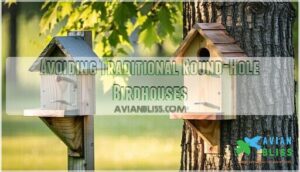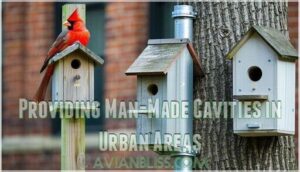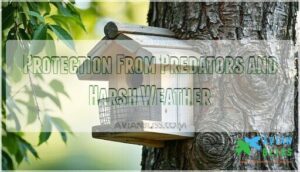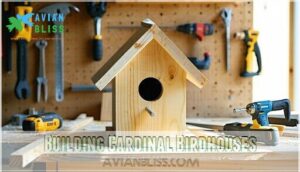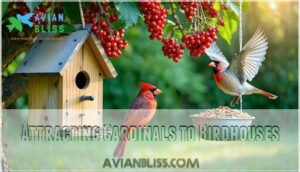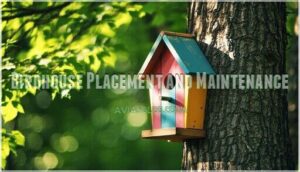This site is supported by our readers. We may earn a commission, at no cost to you, if you purchase through links.
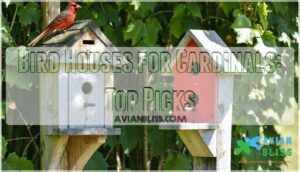
Cardinals prefer open-sided or cavity-style houses with easy access, mimicking their natural nesting spots.
Consider ideal height and placement, avoiding traditional round-hole houses.
By selecting the right bird house, you’ll attract these beautiful birds and provide them with a safe space to nest.
With the right design and placement, you’ll be on your way to creating a cardinal-friendly habitat, and that’s just the beginning of creating a thriving backyard ecosystem.
Table Of Contents
- Key Takeaways
- Choosing Best Birdhouses
- Cardinal Nesting Preferences
- Top 7 Bird Houses for Cardinals
- Building Cardinal Birdhouses
- Attracting Cardinals to Birdhouses
- Birdhouse Placement and Maintenance
- Frequently Asked Questions (FAQs)
- What kind of birdhouse do cardinals like?
- What direction should a cardinal birdhouse face?
- What do cardinals use for shelter?
- How high should a cardinal house be?
- Can a cardinal build a birdhouse?
- What birds use Cardinal birdhouses?
- Do Cardinals live in a birdhouse?
- What is the best birdhouse for Cardinals?
- How big should a birdhouse be for a cardinal?
- Do cardinals use birdhouses in the winter?
- Conclusion
Key Takeaways
- You’ll want to choose a birdhouse that meets cardinals’ unique needs, such as an open-sided or cavity-style house with easy access, to create a safe space for them to nest.
- When placing a cardinal birdhouse, consider the ideal elevation, typically 5-10 feet above ground, and position it near vegetation for proximity and protection from weather exposure.
- Cardinals prefer open-platform nests with easy access, so you’ll want to opt for an open design ledge box or nesting tray that mimics their natural habitat, and avoid traditional round-hole birdhouses.
- To attract cardinals to your birdhouse, offer the right food, like sunflower seeds, and provide a water source, and place the house in late winter to prep for breeding season, ensuring shelter from elements and resource availability.
Choosing Best Birdhouses
You’re looking to choose the best birdhouse for cardinals, and bearing their specific needs in mind is vital.
Choose a birdhouse that meets cardinals’ unique needs for a happy habitat
You’ll want to select a birdhouse that’s open-sided, allowing for easy access, and avoid traditional round-hole birdhouses that aren’t suitable for cardinals.
Considerations for Optimal Height and Placement
When placing a cardinal birdhouse, consider the ideal elevation, typically 5-10 feet above ground, and make certain a safe distance from predators.
Place cardinal birdhouses 5-10 feet high for optimal safety and visibility.
Position it near vegetation for proximity and protection from weather exposure, facilitating attracting cardinals to their preferred habitat.
This will help in attracting cardinals to the area.
Open-Sided Birdhouses for Easy Access
You’re looking for open-sided birdhouses with easy access.
- Open-side benefits
- Cardinal accessibility
- Nesting ledge
- Weather protection
- Predator avoidance
For cardinals, open-sided designs are a popular choice.
for your cardinal birdhouse, opting for an open birdhouse design like a platform birdhouse.
Avoiding Traditional Round-Hole Birdhouses
You’ll want to avoid traditional round-hole birdhouses, as they don’t suit cardinals’ cavity nesting preferences.
Opt for open design ledge boxes or nesting trays instead, which mimic their natural habitat, making your cardinal birdhouse a cozy home with an open birdhouse design and platform birdhouse features.
Consider also that predator guards are essential for protecting birdhouses, which is a critical aspect of creating a safe birdhouse.
Cardinal Nesting Preferences
You’re looking to attract cardinals to your yard, and understanding their nesting preferences is key.
Cardinals prefer open-platform nests with easy access, typically built in dense shrubbery or trees with heavy foliage, so you’ll want to choose a birdhouse that mimics these natural nesting sites.
Natural Cavity Nesting Preferences
You’ll find cardinals prefer natural foliage for nesting, typically 1-2 meters off the ground, using twigs and leaves as nest materials.
They opt for open nesting sites, often rejecting man-made structures, seeking dense vegetation for their cardinal bird habitat and nesting sites.
Providing Man-Made Cavities in Urban Areas
You create urban nesting sites with cavity alternatives.
- Wooden poles
- Building walls
- Metallic pipes
- Tree cavities
- Dead branches
These support city cardinals, providing artificial habitats amidst human impact, ideal for a cardinal birdhouse and Northern cardinals in your backyard.
Protection From Predators and Harsh Weather
You design a cardinal birdhouse with predator deterrents and weather resistance for nesting safety.
Choose durable materials and consider location carefully to protect from harsh weather and birdhouse predators, ensuring a weather-resistant birdhouse with ideal birdhouse placement for a safe and cozy cardinal home.
Top 7 Bird Houses for Cardinals
You’re looking for the best bird houses for cardinals, and you’ve come to the right place.
Here, you’ll find the top 7 bird houses that cater to cardinals’ unique nesting preferences, helping you attract these beautiful birds to your yard.
1. Little Giant Chicken Nesting Box
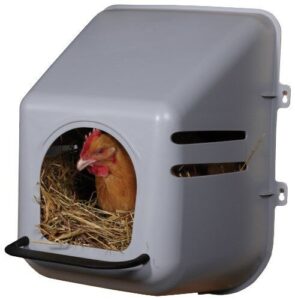
You’re considering the Little Giant Chicken Nesting Box.
Made of high-density polyethylene, it’s durable and easy to clean. This box features an entrance perch and ventilation holes, providing a comfortable space for birds.
Its plastic surface resists rust and corrosion, making it a practical choice for outdoor use, offering a safe nesting spot.
Best For: backyard chicken keepers who want a durable, easy-to-clean, and safe nesting box for their birds.
- May have a shallow depth, which can limit bedding retention
- Does not include backing, requiring additional support to prevent eggs from falling out
- Some users find it pricey compared to alternative options available at local farm stores
- Made of high-density polyethylene, making it durable and resistant to rust and corrosion
- Features an entrance perch and ventilation holes, providing a comfortable space for birds
- Easy to clean and maintain, with a plastic surface that stays warmer in winter
2. Coveside Bird Nesting Perch
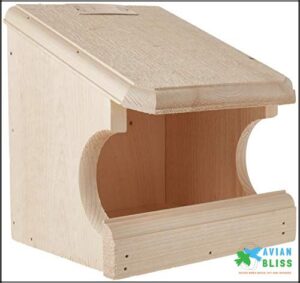
You’re looking at the Coveside Bird Nesting Perch, a platform-style birdhouse made of pine wood.
It features a 7" wide front opening and a 2" tall front lip for perching.
The overhanging roof keeps the area dry.
With predrilled holes for easy mounting, this birdhouse is a great option for cardinals, offering protection from the elements and a cozy spot to nest.
Best For: suburban residential properties with smaller bird species like song sparrows, catbirds, thrashers, phoebes, barn swallows, and robins.
- Easy installation under eaves, inside garages, barns, or on building sides
- Protection from the elements with no maintenance required
- Sturdy construction with attention to detail
- Pricey for widespread use on farms or ranches
- May not be suitable for larger birds like doves
- Requires additional holes or connectors for certain installations
3. Wooden Birdhouse for Garden Viewing
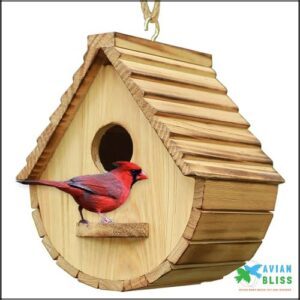
You’re checking out the Wooden Birdhouse for Garden Viewing.
Made from natural wood, it has a rustic charm and is designed for various species.
This birdhouse is easy to clean and fill, providing a safe environment for birds to nest and rest.
It’s a great option for garden viewing and can be painted to blend with surroundings, making it a perfect choice with its rustic charm.
Best For: bird enthusiasts and homeowners who want to attract birds to their yard and provide a safe environment for them to nest and rest.
- The birdhouse is made from natural wood, giving it a rustic charm and durability.
- It is easy to clean and fill, making it a low-maintenance option for bird enthusiasts.
- The birdhouse can be painted to blend with surroundings, allowing it to fit in with any garden or yard decor.
- The front porch or guard roost may not provide a secure grip for bird feet, which could be a problem for some species.
- The birdhouse may have a strong initial scent that requires airing out before use.
- Some users may find the design of the birdhouse to be less functional than others, particularly in terms of the entrance size and shape.
4. Wooden Bird House with Pole

You’re opting for a Wooden Bird House with Pole, a great choice.
Pole-mounted birdhouses offer superior protection from predators.
Made from natural cedar wood or painted pine wood, they require balancing weight distribution for stability.
This model features a sturdy design and adjustable mounting kit, perfect for attracting cardinals to your yard.
Best For: bird or nature lovers who want to attract small birds like bluebirds, wrens, and cardinals to their yard with a durable and easy-to-maintain birdhouse.
- The birdhouse is made of premium natural wood with a sturdy design, providing superior protection from predators.
- It features a latch-unlocked door for easy cleaning and nest preparation, and a small entrance hole to keep larger birds away.
- The birdhouse is lightweight and easy to hang, with a paintable surface for customization to match any outdoor decor.
- Some users reported issues with the perch splitting or cracking during assembly, which can affect the birdhouse’s durability.
- The product may arrive damaged, requiring repairs before use, which can be inconvenient for customers.
- The birdhouse’s sturdiness and long-term durability have received mixed reviews, with some users expressing concerns about its ability to withstand harsh outdoor conditions.
5. Ceramic Hanging Birdhouse for Wild Birds
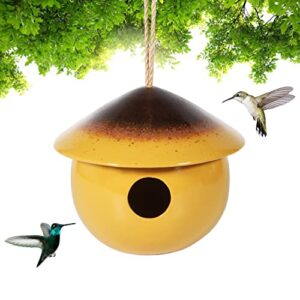
You’re looking for a birdhouse that’s both functional and decorative.
The Ceramic Hanging Birdhouse for Wild Birds is a great option, providing a cozy home for finches, cardinals, and bluebirds.
It’s easy to install and clean, with a rope for hanging, and features two large openings that can also be used as a bird feeder, making it a perfect choice for those looking for a product that serves multiple purposes, such as a home for wild birds and a cozy place for them to live.
Best For: small nesting birds like wrens, finches, chickadees, nuthatches, and titmice who need a cozy and safe home.
- Easy to install and clean with a rope for hanging
- Provides a safe haven for birds from predators and harsh weather
- Can be used as a decorative accent in gardens or patios
- The color may not be as bright as expected, with some customers noting it’s more yellow ochre than bright yellow
- May not be suitable for very large birds or birds that require a lot of space
- Requires regular cleaning to maintain hygiene for new bird guests
6. Cardinal Birdhouse Garden Decor Spoontiques

You’ll love the Cardinal Birdhouse Garden Decor by Spoontiques, a decorative resin birdhouse with fine details and bright red color.
It’s perfect for indoor or outdoor use, adding a pop of color to your space.
This birdhouse isn’t intended for actual bird habitation, but it’s a lovely way to brighten up your yard or home, making it a great decorative piece.
Best For: people looking to add a decorative and colorful piece to their indoor or outdoor space, such as homeowners, gardeners, and those who appreciate decorative resin birdhouses.
- The birdhouse is made of durable resin, making it suitable for outdoor use and able to withstand various weather conditions.
- It’s hand-painted with fine details and bright colors, adding a pop of color to any space.
- The product is lightweight and easy to hang, making it a great option for those who want to add a decorative piece to their yard or home without much hassle.
- The birdhouse is not intended for actual bird habitation, which may be a disappointment for those looking for a functional birdhouse.
- It’s made of resin, which may not be as eco-friendly as other materials.
- The product is decorative only, which may limit its appeal to those who are looking for a functional piece for their yard or home.
7. Alpine Birdhouse Water Fountain Yard Decor
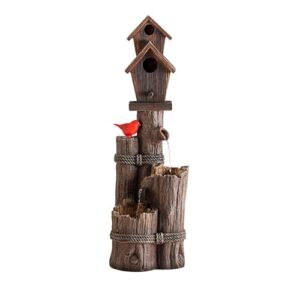
You consider the Alpine Birdhouse Water Fountain Yard Decor, a charming addition to gardens and patios.
Made of polyresin, fiberglass, and stone powder, it features a 3-tier design with cascading water flow.
This birdhouse measures 11"L x 10"W x 35"H, suitable for yards of any size, and includes an interior pump and LED lights for a serene ambiance.
Best For: homeowners who want a unique and charming addition to their gardens or patios, providing a serene ambiance and a functional birdhouse for small birds to nest in.
- The product may experience issues with water splashing out on windy days, and the pump can malfunction, requiring manual monitoring and maintenance.
- Some units may arrive damaged due to inadequate packaging or shipping handling, and used or refurbished units may have leaks, cracks, or incomplete features.
- The product requires regular water refilling, especially in hot climates, and does not have an auto-shutoff feature for the pump, which can lead to pump burnout if not properly maintained.
- The product is made of durable materials, including polyresin, fiberglass, and stone powder, to prevent rotting, rusting, and weather damage.
- It features a 3-tier design with cascading water flow and LED lights, creating a serene and woodland-inspired sound and ambiance.
- The product is easy to assemble and suitable for yards of any size, making it a great option for homeowners with varying outdoor spaces.
Building Cardinal Birdhouses
You’re building a cardinal birdhouse, and to guarantee durability, use the right materials, like exterior-grade plywood or cedar.
You’ll need to assemble the parts carefully, following a design that mimics the birds’ natural nesting sites, with an open front and a roof overhang to protect them from the elements, using a method that ensures durability.
Cutting The Fence Board to Size
To build a cardinal birdhouse, you’ll need accurate measurements and proper blade selection.
Choose the right cutting techniques and follow safety precautions to minimize material waste.
Use a 6-foot 1×8 fence board for construction, ideal for cardinal house plans, to build a sturdy cardinal house with suitable birdhouse wood.
Many options exist if you need a birdhouse, and selecting the right materials is crucial for a successful birdhouse construction.
Assembling The Parts for a Sturdy Birdhouse
Assemble the cardinal birdhouse parts with secure fasteners and durable materials. Make precise cuts for proper alignment, ensuring a sturdy structure.
Use weatherproofing techniques to protect the birdhouse from elements, following cardinal house plans to build a cozy cardinal house with birdhouse screws.
Consider the importance of entrance direction to protect from weather, ensuring a cozy cardinal house with proper alignment and secure fasteners.
Positioning The Hand-Made Cardinal Birdhouse for Success
You position your handmade cardinal birdhouse for success, ensuring sunlight exposure, wind protection, and predator avoidance.
Place it near vegetation for visibility, avoiding human disturbance, to attract Northern cardinals to your cardinal birdhouse, considering the best cardinal house placement for these beautiful birds.
Ideal placement also involves considering birdhouse product availability.
Attracting Cardinals to Birdhouses
You’re looking to attract cardinals to your birdhouse, and it’s great that you’re taking the first step.
By offering the right food, like sunflower seeds, and providing a water source, you can create a welcoming environment for these beautiful birds.
This approach helps in making your yard a haven for cardinals, allowing you to enjoy their presence throughout the year.
Offering Sunflower Seeds and Safflower Seeds
You’re attracting cardinals with seed preferences.
Try these:
- Sunflower seeds
- Safflower seeds
- Cracked corn, offering high-quality seeds in bird feeders, like tray or hopper feeders, to draw cardinals to your cardinal birdhouse.
Providing a Water Source and Native Plants
You provide a water source and native plants.
Cardinals are particularly fond of black oil sunflower seeds.
| Water source types | Native plant benefits |
|---|---|
| Bird baths | Attracts native songbirds |
| Fresh water | Planting for cardinals |
| Ponds | Avoiding insecticides |
| Fountains | Native plant benefits |
Placing The House in Late Winter for Breeding Season
You’re ready to place your cardinal birdhouse.
Consider Winter Placement Timing, setting up in late Fall or January, to prep for Breeding Season.
This guarantees Shelter From Elements and Resource Availability, helping cardinals establish territory and find nesting sites, making your birdhouse location ideal.
Birdhouse Placement and Maintenance
You’re now ready to place your birdhouse in a spot where cardinals will feel safe and comfortable.
You’ll want to mount the house on a tree or pole, and place it near dense vegetation to attract these beautiful birds.
Mounting The House on a Tree or Pole
Now that you’re attracting cardinals, think about cardinal birdhouse placement. Secure attachment is key. Should you choose Pole vs Tree?
Consider these points for birdhouse mounting:
- Safety from cats.
- Protection from wind.
- Best Mounting Height.
- Weather Protection.
- Use of Predator Baffles.
For birdhouse pole mounting, guarantee stability. Mounting Height affects visibility. Whether on a birdhouse tree or pole, a secure setup is critical for success.
Placing The House Near Dense Vegetation
You’ll want to place your cardinal birdhouse near dense vegetation, like shrubs or thickets, for predator protection and nesting materials, while considering visibility concerns and weather exposure, to create a safe haven for Northern cardinals.
Regular bird house maintenance helps prevent pests and diseases.
Avoiding Areas of High Disturbance and Predation
When placing your cardinal birdhouse, consider Pet proximity and Nest concealment to avoid birdhouse predators.
Keep a Safe distance from Human activity to guarantee birdhouse safe spaces, protecting from squirrels and other threats, for a peaceful cardinal haven.
Frequently Asked Questions (FAQs)
What kind of birdhouse do cardinals like?
You’ll attract cardinals with open-platform birdhouses featuring 2-3 open sides, a roof overhang, and no enclosure, mimicking their natural nesting sites in dense shrubs or trees.
What direction should a cardinal birdhouse face?
Notably, you’ll find that facing your cardinal birdhouse east or southeast is ideal, as it provides warmth and protection from harsh weather conditions, making it a cozy spot for cardinals.
What do cardinals use for shelter?
You’ll find cardinals use dense shrubbery, thickets, or small trees for shelter, often building nests with twigs, leaves, and pine needles in these areas.
How high should a cardinal house be?
You’ll want your cardinal house to be around 7 inches high, with 10 inches being ideal, to mimic their natural nesting sites.
Can a cardinal build a birdhouse?
You can’t build a birdhouse for cardinals, they build nests themselves using twigs, leaves, and grasses in dense shrubbery or trees with heavy foliage, typically 1-15 feet above ground.
What birds use Cardinal birdhouses?
You’ll attract robins and other birds to cardinal birdhouses, which are open-fronted nesting boxes with roof overhangs, perfect for birds seeking shelter and safety in dense shrubbery.
Do Cardinals live in a birdhouse?
You’ll notice Cardinals don’t typically live in traditional birdhouses, instead preferring open-fronted nesting boxes or dense shrubbery with a natural, sheltered space to raise their young.
What is the best birdhouse for Cardinals?
You’re a architect for birds, designing a home like an open-fronted birdhouse with a roof overhang, perfect for Cardinals, using durable materials and a simple design.
How big should a birdhouse be for a cardinal?
You’ll want a birdhouse that’s approximately 19" L x 88" W x 75" H, with an open front and roof overhang, to mimic cardinals’ natural nesting sites.
Do cardinals use birdhouses in the winter?
You might think cardinals use birdhouses in winter, but they actually don’t, preferring natural shelters like dense shrubs or trees for protection from harsh weather conditions instead.
Conclusion
Setting the stage for a cardinal paradise, you’re now equipped to choose the perfect bird houses for cardinals, with ideal height and placement in mind, to create a safe haven.
By selecting the right bird houses for cardinals, you’ll attract these beautiful birds and enjoy their sweet songs.
- https://web.archive.org/web/20190426223637id_/https:/www.zora.uzh.ch/id/eprint/154771/1/ZORA_NL_154771.pdf
- https://core.ac.uk/reader/232842410
- https://www.songbirdgarden.com/store/scripts/prodList.asp?idCategory=83
- https://www.woodducknestboxes.com/robin.html
- https://www.duncraft.com/Duncraft-Cardinal-Bird-House



